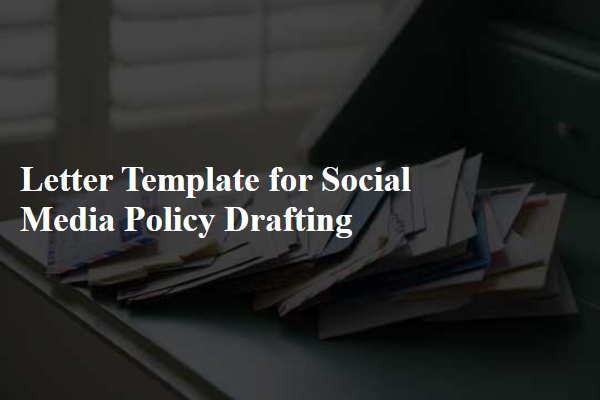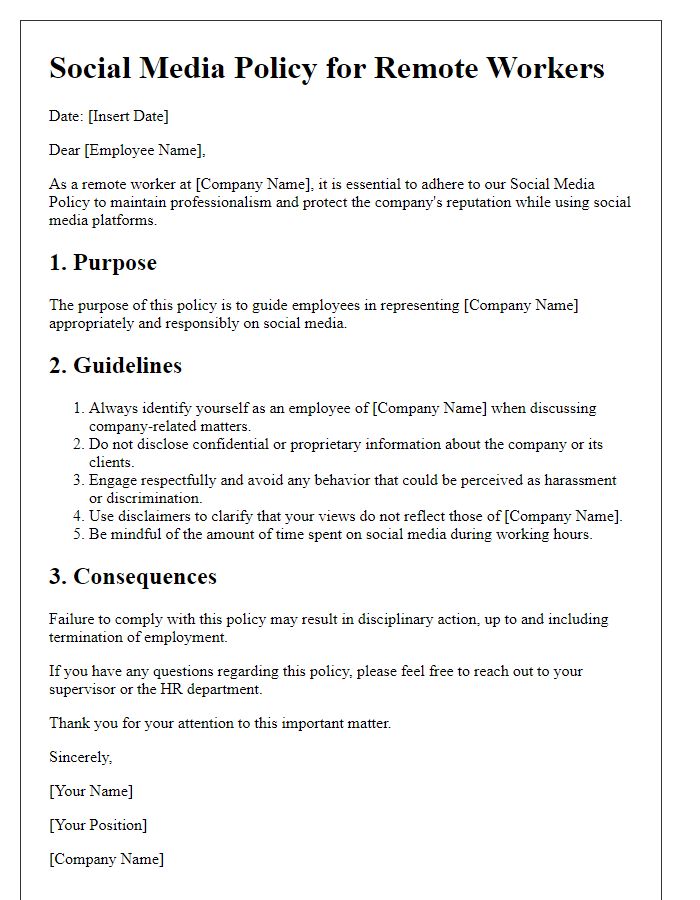Creating a social media policy can feel like a daunting task, but it doesn't have to be! It's all about establishing clear guidelines that help your team navigate the digital landscape while protecting your brand's reputation. By developing a solid framework, you can foster a positive online presence and ensure that everyone understands their role in maintaining that. Curious about how to craft the perfect social media policy? Keep reading to discover tips and templates that will make the process a breeze!

Purpose and Scope
A social media policy outlines guidelines for employee behavior while representing the organization online. This policy aims to protect the company's reputation and provide a clear framework for appropriate online conduct. It applies to all employees, contractors, and representatives across various platforms including Facebook, Twitter, LinkedIn, and Instagram, ensuring that interactions remain professional and respectful. By establishing consistent standards, the policy fosters a positive online presence while safeguarding sensitive information and promoting brand integrity. Additionally, it addresses the potential consequences of policy violations, reinforcing the importance of responsible social media engagement within the workplace.
Acceptable Use Guidelines
Social media platforms, including Facebook, Twitter, and Instagram, have become crucial tools for communication and branding. Acceptable use guidelines are essential for organizations to maintain professionalism and protect their reputation. These guidelines typically include rules about posting content, such as avoiding offensive language, hate speech, or any form of harassment. Employees should also refrain from sharing confidential information related to their workplace, ensuring compliance with privacy regulations like GDPR (General Data Protection Regulation). Additionally, guidelines often specify that individuals should represent their company accurately, clearly indicating personal opinions versus official brand stances. Organizations may also provide information on how to report inappropriate content or behavior, fostering a respectful online community. Regular training sessions on social media best practices can help reinforce these policies and keep employees updated on any legal changes or platform updates.
Confidentiality and Privacy
Confidentiality and privacy in social media policies are crucial for protecting sensitive information within organizations such as companies or educational institutions. Social media platforms like Facebook, Twitter, and Instagram can expose private data if employees share confidential details. For instance, breaches may involve sharing customer information (like addresses or financial data), internal company strategies (such as marketing plans), or proprietary technology insights (like product development secrets). Organizations should implement guidelines outlining the types of information that must remain confidential, consequences of policy violations, and the importance of privacy settings on personal accounts. Additionally, training sessions can ensure that staff understand their responsibilities regarding confidential information and privacy on digital platforms.
Content Moderation Procedures
Content moderation procedures are essential for maintaining a safe and respectful online environment across platforms like Facebook, Instagram, and Twitter. Guidelines outline acceptable behavior, specifying that hate speech, harassment, and graphic content must be removed within 24 hours of reporting. Human moderators review flagged content at least twice a day to ensure compliance, while automated systems help identify potential violations using machine learning algorithms. Regular training sessions enhance moderator skills, focusing on cultural sensitivity and context understanding. Additionally, periodic audits, conducted quarterly, assess policy effectiveness and include user feedback surveys to refine and update protocols as needed.
Compliance and Legal Considerations
Developing a comprehensive social media policy requires careful attention to compliance (adherence to laws and regulations) and legal considerations (possible liabilities or rights). Key aspects include defining the target audience (specific demographic groups), selecting appropriate platforms (such as Facebook, Twitter, LinkedIn), and establishing guidelines for acceptable content (avoid offensive material). Organizations should also outline privacy concerns (protection of personal information) and intellectual property rights (ownership of original content). Additionally, consider monitoring and moderation procedures (regular review of user interactions) to mitigate risks associated with negative comments or misinformation. Training employees on the policy (education programs) plays a crucial role in ensuring awareness and adherence. Lastly, periodic audits (evaluations conducted regularly) of the policy's effectiveness can help adapt to changing legal landscapes or shifting social media practices.













Comments